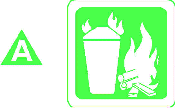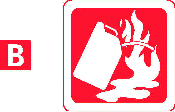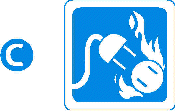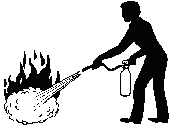FIRE EXTINGUISHERS
Your Extinguisher Must Fit the Fire
 |
Type A: Ordinary combustibles. Wood, cloth, paper, rubber, many plastics,
and other common materials that burn easily.
These fires are extinguished by the heat absorbing effect of water or
water based liquids, or by smothering the fires.
|
 |
Type B: Flammable liquids. Gasoline and other flammable liquids, oil,
grease, tar, oil-based paint, lacquer and flammable gas.
These fires can be extinguished by excluding air, by inhibiting the
release of combustible vapor or by interrupting the combustion chain reaction.
|
 |
Type C: Electrical Equipment. Energized electrical equipment, including
wiring, fuse boxes, circuit breakers, machinery and appliances.
These are extinguished with an agent that is electrically nonconducting
in order to avoid shock hazard to the user.
|
Class D fires are limited to combustible metals, such as magnesium.
Class D fires require a smothering and heat absorbing extinguishing agent that does not react
with the burning metal.
Class K fires are fires in cooking appliances that involve combustible
cooking media (vegetable or animal oils and fats).
Fire Extinguisher Operation P.A.S.S.
When used properly, a portable fire extinguisher can save lives and property
by putting out a small fire or containing it until the fire department
arrives. Portable extinguishers, however, are not designed to fight a large or
spreading fire.
 |
Pull the locking pin, breaking the seal. |
 |
Aim nozzle or hose just in front of the base of the fire. |
 |
Squeeze the trigger handle all the way. |
 |
Sweep discharge from side to side, moving front to back, across
the base of the fire. |


